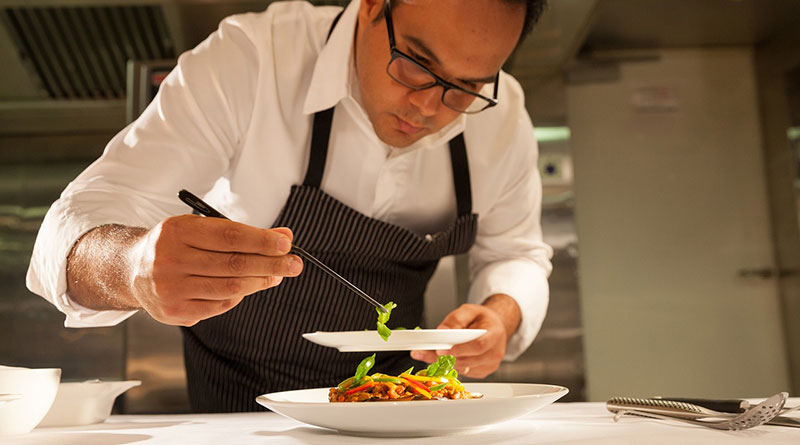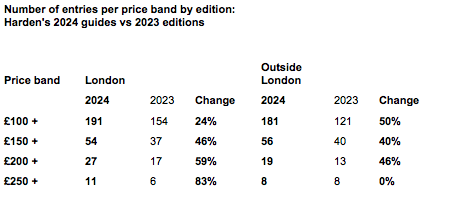£150+ Per Head Eateries Are Making Top Restaurants An Ever-Less Affordable Luxury

Amongst restaurants charging over £100 per head, above-inflation restaurant price hikes of 10.7% in London and 14.7% outside London are swelling a new tier of hyper-luxurious restaurants, increasingly out of reach even of relatively affluent diners.
That’s the conclusion of the new edition of Harden’s London Restaurants 2024 (published today), as supplemented by price data from Harden’s national guide (Harden’s Best UK Restaurants 2024) which will be published next month in December 2024.
The new 2024 guide notes there are now 54 restaurants in London (and 56 nationally) charging over £150 per head for a meal: a rise of nearly 50% year-on-year. By contrast in 2016, there was only one establishment in the capital (and 5 nationally) at such a price level. Growth is most pronounced in the number of restaurants charging over £200 per head, with the number of such entries growing 59% and 46% respectively inside and outside the capital.
The guide, which reviews and rates over 1,600 restaurants at all price points also highlights the “tepid” state of growth in a London restaurant scene, which has failed post-Covid to retain the vitality it has shown since 2000. The opening rate of 123 newcomers in the 2024 guide is the lowest level of openings since its 2012 edition, which – combined with a relatively high rate of 77 closures – equates to a current level of net openings more in line with the growth rate in the 1990s than that since 2000, despite London’s 30% population growth since the start of the millennium.
Using conclusions from its detailed annual national diners’ poll of 2,500 diners, the new London guide charts the Noble Rot chain as an emerging force in the capital’s restaurant scene, for the first time with an entry in both the Top 10 and Top 20 most-mentioned restaurants. Henry Harris’s Bistro Racine was the most mentioned newcomer in the guide and is hailed as a “fabulous successor to the legendary Racine’.
Unlike most restaurant rating systems, Harden’s 1-5 rating system is benchmarked by price and value, and top marks are awarded to cheaper restaurants as readily as those in the top price tiers.
Amongst the cheaper restaurants in the guide’s ‘Top of the Pots’ pick, the Indian restaurant Dastaan in Ewell was the top performer in the cheapest (£54 or less) category (“not utterly ridiculous to hail it as the very best Indian food in the UK at any price point, and yet it’s still very reasonably priced compared with the Indian palaces of Marylebone and Knightsbridge”); followed by Euston’s Roti King (“a great, basic pit stop on a dodgy street near Euston station where you pack in tight for the amazing, fresh and feather-light rotis”).
Amongst the top tier winners, Endo Kazutoshi’s “zen-like” Japanese at the top of the former TV Centre – Endo at the Rotunda – again achieved the guide’s highest rating for food, and Clare Smyth’s Core was most nominated for where diners enjoyed their Top Gastronomic Experience of the year. For the first time, the Stafford Collection’s Norma achieved the highest food rating for an Italian restaurant, and Bibi provided another winner for the JKS Restaurants group, becoming the capital’s top Indian restaurant for the first time.
Modern British was the most popular cuisine choice for new openings with 30 restaurant debuts across London. Italian was the next favourite (with 18 new openings) followed by Japanese (with 10 openings). In terms of location, Central London remained dominant, with 50 arrivals. In the ’burbs, South London led the way for once (with 21 openings) boosted by the Battersea Power Station development. East London followed (with 19 openings); while West London equalled North London’s rate of opening (with 16 apiece).
The guide’s editor and co-founder Peter Harden noted:
“It’s somewhat ironic that the venue diners most often nominate as London’s most overpriced restaurant is still the River Café. But at £150 per head, it’s definitely no longer an outlier in terms of pricing: perhaps it’s just that the middle class diners who take part in our survey can still just about afford to go there.
It is tempting to conclude that the capital is becoming a playground for what used to be called “the jet set”. But historically one of the striking features of the London restaurant scene has been its lack of a top tier of splurgy, expensive destinations such as those that have long characterised top-end dining in Paris and Tokyo. Perhaps it is perverse to complain if London can now hold its own internationally.”

